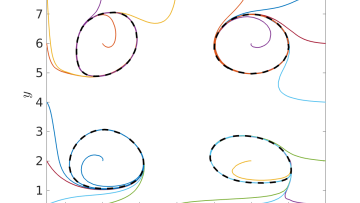Intrinsic models on Riemannian manifolds with bounded curvature
Abstract
We investigate the long-time behaviour of solutions to a nonlocal partial differential equation on smooth Riemannian manifolds of bounded sectional curvature. The equation models self-collective behaviour with intrinsic interactions that are modeled by an interaction potential. Without the diffusion term, we consider attractive interaction potentials and establish sufficient conditions for a consensus state to form asymptotically. In addition, we quantify the approach to consensus, by deriving a convergence rate for the diameter of the solution’s support. With the diffusion term, the attractive interaction and the diffusion compete. We provide the conditions of the attractive interaction for each part to win.
On the Incompressible Limit for a Tumour Growth Model Incorporating Convective Effects
Abstract
In this seminar, we study a tissue growth model with applications to tumour growth. The model is based on that of Perthame, Quirós, and Vázquez proposed in 2014 but incorporated the advective effects caused, for instance, by the presence of nutrients, oxygen, or, possibly, as a result of self-propulsion. The main result of this work is the incompressible limit of this model, which builds a bridge between the density-based model and a geometry free-boundary problem by passing to a singular limit in the pressure law. The limiting objects are then proven to be unique.
In 1900, David Hilbert posed his list of 23 mathematical problems. While some of them have been resolved in subsequent years, a few of his challenging questions remain unanswered to this day. One of them is Hilbert's 16th problem, which asks questions about the number of limit cycles that a system of ordinary differential equations can have. Such equations appear in modelling real-world systems in biological, chemical or physical applications, where their solutions are functions of time.


